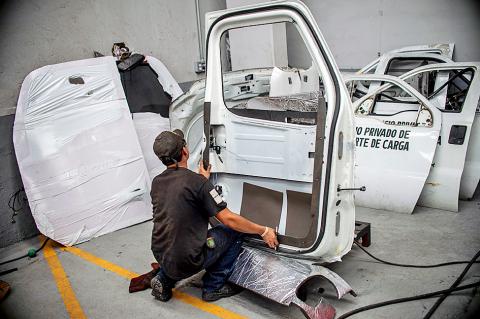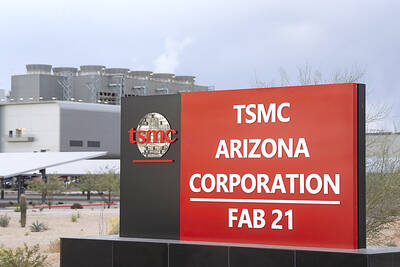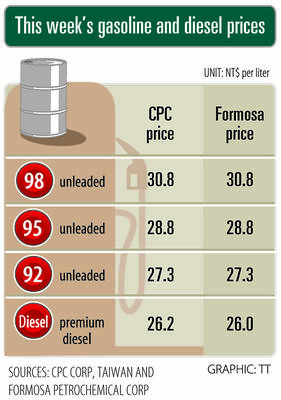The speeding cars pulled alongside a semi-truck, boxed it in and forced it to a halt. Then the robbers, firing AK-47s, hijacked its cargo and made their getaway.
It seems like something out of Hollywood, but it is happening on a daily basis on Mexico’s highways.
The mounting dangers on the road have fueled a booming new business as the trucking industry seeks to fight back: Welcome to the world of armored and bulletproof tractor-trailers.

Photo: AFP
Jorge Coronel is one of those trying to stop these highway robberies, which have more than doubled in Mexico since 2015 to more than 30 each day, according to figures from the trucking industry and the government.
Coronel runs a company that specializes in transporting high-value cargo such as electronics, appliances, pharmaceuticals and luxury clothes.
Many insurance companies operating in Mexico will no longer protect such shipments unless they are transported in vehicles capable of withstanding assault rifle fire.
“It’s a growing niche,” Coronel told reporters. “It’s expensive. It’s very expensive, but insurance companies are demanding armored equipment for shipments worth more than a certain amount.”
Mexico is caught in the seemingly never-ending spiral of violent crime driven by its powerful drug cartels and other organized gangs.
First, the criminals branched out into fuel theft, which has cost state oil company Petroleos Mexicanos billions of dollars. Now, they are plaguing the country’s highways.
Mexican police received 11,425 reports of armed robberies of cargo vehicles in 2017 — or an average of more than 31 per day.
Last year, there were 11,062 reports from January to November — 33 per day.
To defend against the scourge, armored truck companies are coating tractor-trailers in steel and putting bulletproof glass in the windows.
It costs about 550,000 Mexican pesos (US$28,822) to equip a semi-truck to withstand AK-47 fire.
However, for many shipping companies, there is little choice. A single high-value shipment can be worth nearly US$500,000.
The trucking industry has estimated that it is losing US$4.6 billion per year because of violent crime.
Coronel has experienced the consequences firsthand.
In 2017, one of his company’s trucks was transporting a load of clothing when it lost contact with its escort near Ecatepec, a dangerous area outside Mexico City.
His team used remote control technology to bring the semi to a stop. As the robbers threatened the driver, the client shipping the merchandise decided to take no chances.
The client told him to “hand over the cargo and not put the driver at risk,” he said.
Attacks are getting more sophisticated and also more violent, said Daniel Portugal, who runs armoring company Diamond Glass.
“These days, they use cars in front to block the road and then they pull up on both sides. They don’t even try to damage the semi-truck, they go straight for the driver,” he said.
An industry that once focused mostly on armored trucks and VIP cars has had to adapt to new demand for the bulletproof semis.
For Esteban Hernandez, head of the Mexican Association of Armored Automakers, the industry is locked in a technological race with the criminals.
“The trucks have GPS devices that send their location in case of an unplanned stop, but the criminals have their own devices to jam the GPS,” Hernandez said.
“Their modus operandi is to climb the steps and enter the truck, so we developed a mechanism to retract the steps inside the vehicle when the driver isn’t using them,” he said.
Mexican trucking firms spend an estimated 6 percent of their revenues on security, versus about 0.5 percent worldwide, industry figures showed.
Companies are increasingly telling their drivers that they are safer inside their trucks in the event of a robbery.
“We give them training so they’ll trust the truck. The most important thing is not to get out of the vehicle,” Diamond Glass special services director Rigoberto Sierra said.
“If you’re inside the truck and it gets hit by a bullet, you might have your doubts, but we need our drivers to hold on tight and say: ‘I’m not budging,’” he said.

Taiwan Semiconductor Manufacturing Co (TSMC, 台積電), the world’s biggest contract chipmaker, booked its first-ever profit from its Arizona subsidiary in the first half of this year, four years after operations began, a company financial statement showed. Wholly owned by TSMC, the Arizona unit contributed NT$4.52 billion (US$150.1 million) in net profit, compared with a loss of NT$4.34 billion a year earlier, the statement showed. The company attributed the turnaround to strong market demand and high factory utilization. The Arizona unit counts Apple Inc, Nvidia Corp and Advanced Micro Devices Inc among its major customers. The firm’s first fab in Arizona began high-volume production

VOTE OF CONFIDENCE: The Japanese company is adding Intel to an investment portfolio that includes artificial intelligence linchpins Nvidia Corp and TSMC Softbank Group Corp agreed to buy US$2 billion of Intel Corp stock, a surprise deal to shore up a struggling US name while boosting its own chip ambitions. The Japanese company, which is adding Intel to an investment portfolio that includes artificial intelligence (AI) linchpins Nvidia Corp and Taiwan Semiconductor Manufacturing Co (TSMC, 台積電), is to pay US$23 a share — a small discount to Intel’s last close. Shares of the US chipmaker, which would issue new stock to Softbank, surged more than 5 percent in after-hours trading. Softbank’s stock fell as much as 5.4 percent on Tuesday in Tokyo, its

The prices of gasoline and diesel at domestic fuel stations are to rise NT$0.1 and NT$0.4 per liter this week respectively, after international crude oil prices rose last week, CPC Corp, Taiwan (台灣中油) and Formosa Petrochemical Corp (台塑石化) announced yesterday. Effective today, gasoline prices at CPC and Formosa stations are to rise to NT$27.3, NT$28.8 and NT$30.8 per liter for 92, 95 and 98-octane unleaded gasoline respectively, the companies said in separate statements. The price of premium diesel is to rise to NT$26.2 per liter at CPC stations and NT$26 at Formosa pumps, they said. The announcements came after international crude oil prices

SETBACK: Apple’s India iPhone push has been disrupted after Foxconn recalled hundreds of Chinese engineers, amid Beijing’s attempts to curb tech transfers Apple Inc assembly partner Hon Hai Precision Industry Co (鴻海精密), also known internationally as Foxconn Technology Group (富士康科技集團), has recalled about 300 Chinese engineers from a factory in India, the latest setback for the iPhone maker’s push to rapidly expand in the country. The extraction of Chinese workers from the factory of Yuzhan Technology (India) Private Ltd, a Hon Hai component unit, in southern Tamil Nadu state, is the second such move in a few months. The company has started flying in Taiwanese engineers to replace staff leaving, people familiar with the matter said, asking not to be named, as the